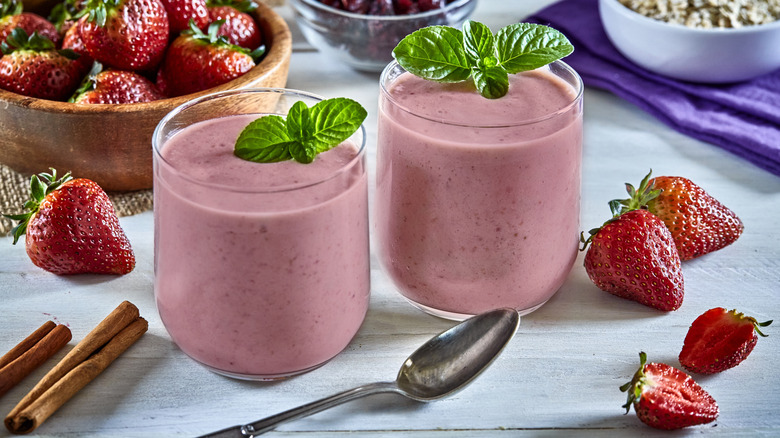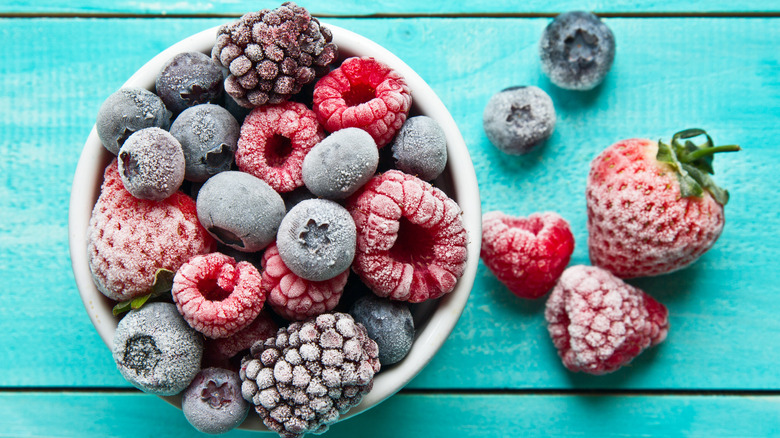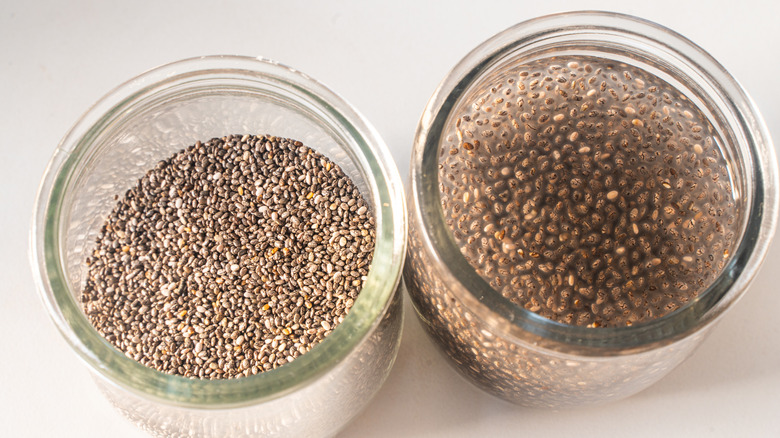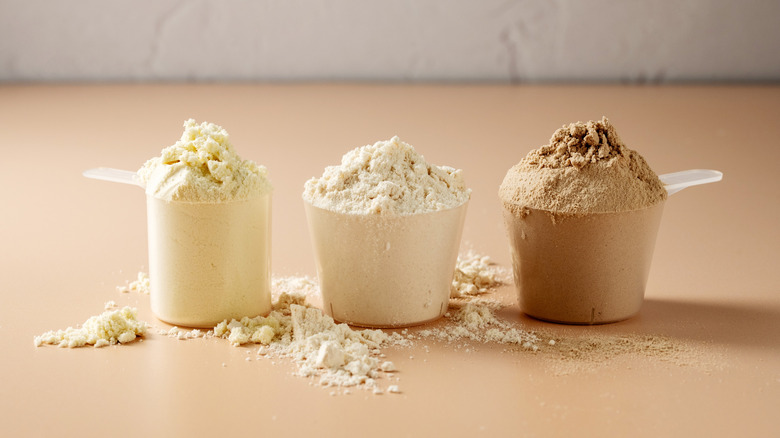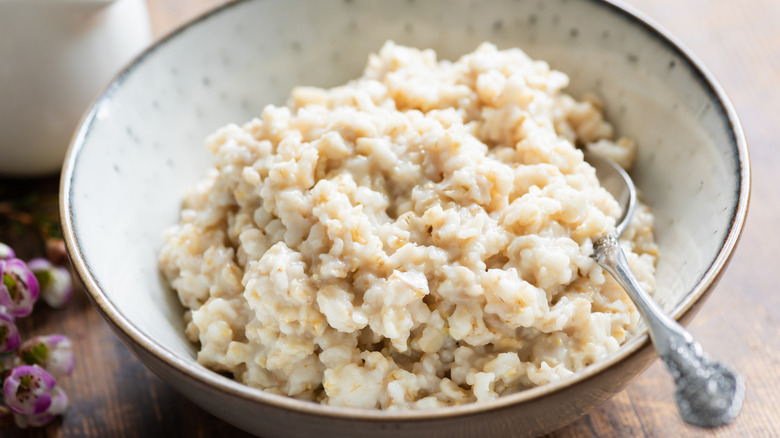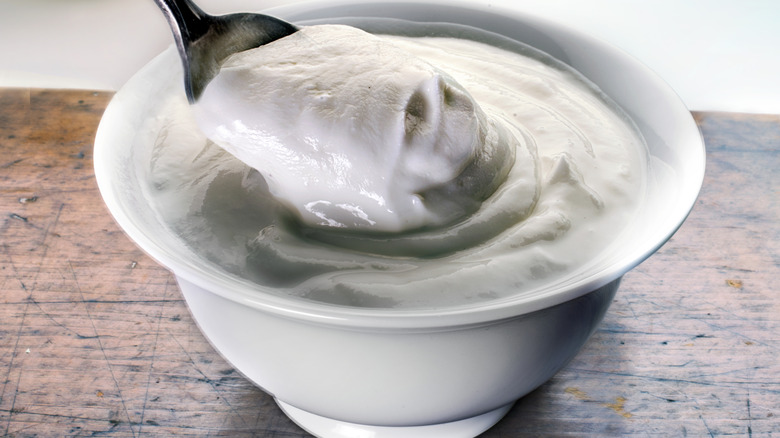The 5 Best Tricks To Make Your Smoothies Thicker
While there are many types of blended drinks including milkshakes, frappuccinos, and frozen cocktails, the smoothie generally stands out as something that's at least meant to be semi-healthy. If you're making your smoothies right, they should not only taste good but also offer some sort of health benefit. If nutrition is a non-issue, why not just drink a shake and be done with it? Apart from this, though, smoothies also need to have the proper texture. As the name implies, the beverage should be smooth, not lumpy, and should also be thick enough to make for a satisfying meal on the go instead of a simple thirst quencher.
The very earliest smoothies may have included little more than pureed fruit, while the "smoothees" included in a 1947 Waring blender cookbook were heavily milk-based and on the thin side. By the '90s, smoothies started to include leafy green vegetables in addition to fruit and dairy, but just dropping kale and strawberries into a blender full of milk and hitting "start" probably won't result in the thick, satisfying drink that we've now come to expect. While you could always add ice cubes to thicken the mixture, they'd be hard on the blender blades and would also result in a watered-down drink if you don't chug it fast enough. The following suggestions, however, will all improve your smoothie's texture as well as add extra value in the way of flavor or nutrients.
Start with frozen fruit
While many cooks seem to have adopted the mantra that "fresh is always best," that isn't always true. Just as canned pumpkin puree can make better pies and canned tomatoes a more consistent marinara, so, too, does frozen fruit make for a better smoothie. And by better, we mean thicker. (Fresh food fans, you can have your fruit and drink it, too, since you'll get the same results buying fresh and freezing at home.)
Frozen fruit can thicken your smoothie in much the same way that adding ice would, but is softer and will do less damage to the blender. What's more, when it warms up, it will just become slightly mushier fruit, so it won't water down your smoothie at all. Frozen strawberries, which are a similar size to ice cubes, are perfect smoothie thickeners, although sliced frozen bananas, mangoes, or peaches can also work great if you prefer these flavors. Smaller berries, too, can be delicious, although some have seeds that will lend some noticeable texture.
Try chia seeds
Once upon a time, not too many decades ago, chia seeds were primarily known as something you'd mix into a paste and smear all over a clay head or body to result in a Chia Pet covered with green "hair". By the '90s, though, people realized that these seeds were chock full of vitamins and minerals. Once they began eating them, they also noticed an interesting phenomenon: Chia seeds, when soaked in liquid, turn into a kind of gel. This means they can be used to make jam, lend texture to non-dairy pudding, and can even replace eggs in baking. What's more to the point, though, is the fact that chia seeds can also thicken a smoothie.
If you just dump the seeds straight into the blender, you'll need to wait 10 minutes or more until they set up and the smoothie gets thicker. Plan-ahead types may want to have chia gel already on hand in the fridge, as you can just stir this into the smoothie and watch it get to work straight away. To make it, combine one part seeds with eight parts water and let it stand for at least 15 minutes. During this time, you should stir the mix periodically to make sure the seeds disperse throughout the water instead of sticking together and forming lumps.
Add protein powder
At fast food chains such as Tropical Smoothie Cafe, you can usually order protein powder as a supplement for your smoothie. The main reason you might do this is to get some extra protein in your daily diet, but when you're making smoothies at home, keep in mind that protein powder can also help to thicken them. The trick is to balance the proportions, as too much floury powder might turn your smoothie doughy, or at least give it a chalky taste. Just a single scoop, though, will serve as a more subtle thickener.
If you'll be buying protein powder primarily for thickening purposes, look for one that contains xanthan gum. This substance is often used as a thickener and can help keep things smooth. If you want a protein boost but don't have commercial powder on hand, you can DIY it by blending equal parts of finely ground hemp protein, chia seeds, and flax seeds. For an even simpler powdery protein boost, use nuts ground to a powder. Almond flour can also work as a smoothie thickener since it's made from the same base ingredients as almond protein powder. The latter may be a bit finer in texture, but the two products can often be used in similar ways.
Oatmeal thickens and adds fiber
Yet another way to boost the protein and fiber of your smoothie while thickening it at the same time involves another breakfast staple you might already have in your pantry: oatmeal. The quickest way involves adding ¼ cup of raw rolled oats to the rest of the smoothie ingredients, but this will, of course, affect the texture. If you'd rather your smoothie be less chewy, you might want to grind the oats into a powder first.
If you hate food waste as much as we do, though, be aware that you can also add leftover oatmeal to a smoothie. Either cooked or overnight oats will work. If you heat the oatmeal in the microwave first, though, it will help it blend better, and you should also combine the oatmeal with the liquid component of the smoothie before adding the fruit or other ingredients. Blend it for an extra long time to break down the oats as much as possible so your smoothie will stay smooth. Well-incorporated oatmeal, will both make your drink thicker and more filling.
Dairy (or a substitute) will do the trick
Some dictionary definitions of smoothie seem to assume it's a drink primarily made of fruit mixed with milk or yogurt, and in earlier times this may have been true. Now, however, there are more ingredient options, so a wider definition might reflect the fact that smoothies typically involve produce of some sort blended with liquid. The creamiest ones, however, will involve cream, or at least milk. Milk on its own won't make a smoothie super-thick, though. For that, you need a different dairy option.
Yogurt is a typical smoothie thickener, and up to half a cup can be used to take the place of other liquids. For a more plant-based alternative, however, silken tofu can be used to make a DIY protein-rich soy yogurt alternative. Finally, you always have the option of thickening your smoothies with ice cream. This may not be the healthiest choice, but it is a dictionary-sanctioned alternative and will provide calcium as well as a tasty vehicle for consuming whatever fruits you've added to your smoothie.
